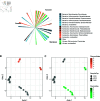Whole blood transcriptomics analysis of Indonesians reveals translocated and pathogenic microbiota in blood
- PMID: 40705807
- PMCID: PMC12289045
- DOI: 10.1371/journal.pone.0328788
Whole blood transcriptomics analysis of Indonesians reveals translocated and pathogenic microbiota in blood
Abstract
Pathogens found within local environments are a major cause of morbidity and mortality. This is particularly true in Indonesia, where infectious diseases such as malaria or dengue are a significant part of the disease burden. Unequal investment in medical funding throughout Indonesia, particularly in rural areas, has resulted in under-reporting of cases, making surveillance challenging. Here, we use transcriptome data from 117 healthy individuals living on the islands of Mentawai, Sumba, and the Indonesian side of New Guinea Island to explore which pathogens are present within whole blood. We identified diverse microbial taxa in RNA-sequencing data from whole blood but found no evidence of a consistent core microbiome across the Indonesian cohort. Yet, Flaviviridae and Plasmodium stood out as the most predominantly abundant taxa, particularly in samples from the easternmost island within our Indonesian dataset. The high prevalence of Plasmodium, the pathogen responsible for malaria, aligns with epidemiological data showing that the Indonesian part of New Guinea has the country's highest malaria rates. We also compare the Indonesian data to two other cohorts from Mali and UK and find a distinct microbiome profile for each group. Higher levels of dissimilarity were found between UK cohort (urban) compared to Indonesian and Malian cohorts (rural), where the former also have significantly lower within-population dissimilarity. This study provides a framework for RNA-seq as a possible retrospective surveillance tool and an insight to what makes up the transient human blood microbiome.
Copyright: © 2025 Bobowik et al. This is an open access article distributed under the terms of the Creative Commons Attribution License, which permits unrestricted use, distribution, and reproduction in any medium, provided the original author and source are credited.
Conflict of interest statement
The authors have declared that no competing interests exist.
Figures




Similar articles
-
Drugs for preventing postoperative nausea and vomiting in adults after general anaesthesia: a network meta-analysis.Cochrane Database Syst Rev. 2020 Oct 19;10(10):CD012859. doi: 10.1002/14651858.CD012859.pub2. Cochrane Database Syst Rev. 2020. PMID: 33075160 Free PMC article.
-
Mass drug administration for malaria.Cochrane Database Syst Rev. 2013 Dec 9;2013(12):CD008846. doi: 10.1002/14651858.CD008846.pub2. Cochrane Database Syst Rev. 2013. Update in: Cochrane Database Syst Rev. 2021 Sep 29;9:CD008846. doi: 10.1002/14651858.CD008846.pub3. PMID: 24318836 Free PMC article. Updated.
-
Effects of a gluten-reduced or gluten-free diet for the primary prevention of cardiovascular disease.Cochrane Database Syst Rev. 2022 Feb 24;2(2):CD013556. doi: 10.1002/14651858.CD013556.pub2. Cochrane Database Syst Rev. 2022. PMID: 35199850 Free PMC article.
-
Primaquine for reducing Plasmodium falciparum transmission.Cochrane Database Syst Rev. 2012 Sep 12;(9):CD008152. doi: 10.1002/14651858.CD008152.pub2. Cochrane Database Syst Rev. 2012. Update in: Cochrane Database Syst Rev. 2014 Jun 30;(6):CD008152. doi: 10.1002/14651858.CD008152.pub3. PMID: 22972117 Updated.
-
Antidepressants for pain management in adults with chronic pain: a network meta-analysis.Health Technol Assess. 2024 Oct;28(62):1-155. doi: 10.3310/MKRT2948. Health Technol Assess. 2024. PMID: 39367772 Free PMC article.
References
-
- McQuiston JH, Montgomery JM, Hutson CL. Ten years of high-consequence pathogens—research gains, readiness gaps, and future goals. Emerg Infect Dis. 2024;30(4). doi: 10.3201/eid3004.240160 - DOI
MeSH terms
Supplementary concepts
LinkOut - more resources
Full Text Sources

